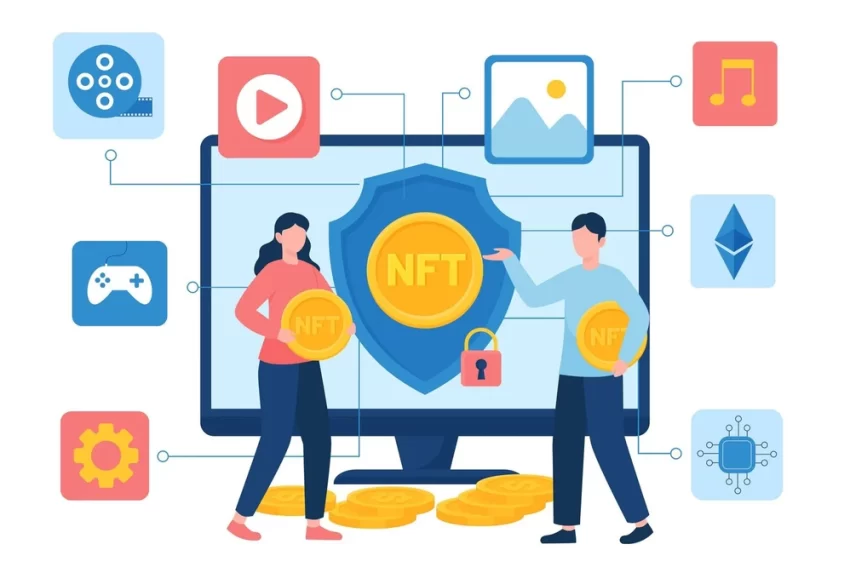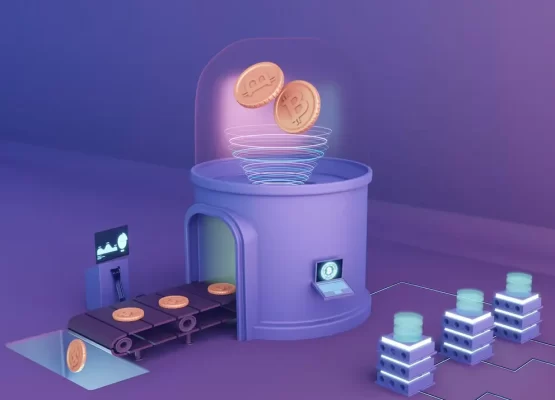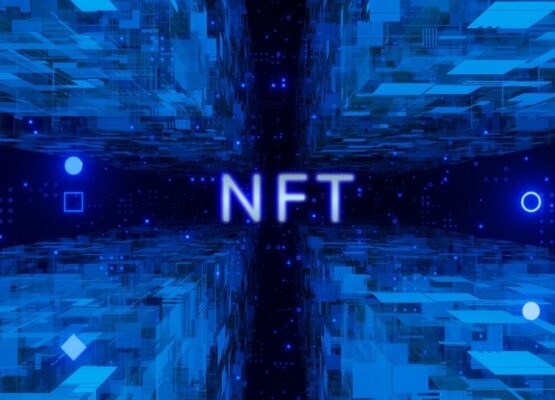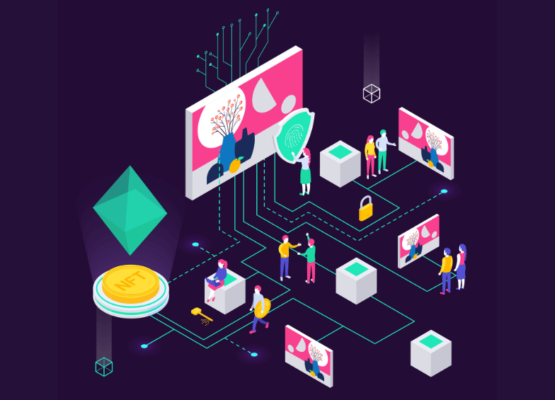Introduction to NFT Marketplaces
NFT (Non-Fungible Token) marketplaces have emerged as a revolutionary platform for buying, selling, and trading digital assets. These marketplaces leverage blockchain technology to provide a secure and transparent ecosystem where creators and collectors can interact. NFTs, unlike cryptocurrencies, represent unique digital items like artwork, music, videos, virtual real estate, and more.
The rise of NFTs has sparked a global frenzy, attracting artists, musicians, gamers, and collectors who see the potential of this new form of digital ownership. NFT marketplaces serve as the primary gateway for users to discover, purchase, and manage these one-of-a-kind digital assets.
In an NFT marketplace, creators can mint their digital assets as NFTs, assign ownership rights, and set their desired price. Collectors, on the other hand, can browse through various categories, search for specific items, and make purchases using cryptocurrencies. The marketplace acts as an intermediary, facilitating transactions and ensuring the authenticity and provenance of the NFT development.
NFT marketplaces have democratized the art and digital asset industry by providing a platform where artists and creators can directly connect with their audience. They have also opened up new avenues for monetization, allowing creators to earn royalties from secondary market sales.
The success of NFT marketplaces largely depends on the features and functionalities they offer. A seamless user experience is crucial for attracting both creators and collectors. From user registration and NFT listing to secure transactions and community engagement, NFT marketplaces must provide a comprehensive set of features to foster a vibrant ecosystem.
In the following sections, we will explore the key features and functionalities that contribute to a seamless user experience in NFT marketplaces, enabling both creators and collectors to thrive in this exciting digital landscape.
Understanding NFTs and their Role in Digital Ownership
NFTs, or Non-Fungible Tokens, have gained significant attention and popularity in recent years. They have revolutionized the concept of digital ownership by enabling the tokenization of unique digital assets on blockchain networks. To understand their role in digital ownership, let’s delve deeper into what NFTs are and how they work.
Unlike cryptocurrencies such as Bitcoin or Ethereum, which are fungible and can be exchanged on a one-to-one basis, NFTs are indivisible and represent one-of-a-kind assets. Each NFT has a unique identifier that distinguishes it from other tokens, making it non-interchangeable. This uniqueness is crucial when it comes to representing ownership of digital assets like art, music, videos, virtual real estate, collectibles, and more.
NFTs leverage blockchain technology, typically built on Ethereum, to establish a transparent and decentralized system for tracking ownership and provenance. The blockchain serves as a public ledger that records all transactions related to NFTs, ensuring immutability and preventing fraudulent activities.
When an artist or creator mints an NFT, they create a digital certificate of ownership for a specific asset. This certificate contains metadata that provides information about the asset, such as its title, description, image or video file, and other relevant details. This metadata is stored on the blockchain, linking it to the unique identifier of the NFT.
Once minted, NFTs can be bought, sold, and traded on NFT marketplaces. Each transaction involving an NFT is recorded on the blockchain, allowing for a transparent and verifiable history of ownership transfers. Collectors who purchase NFTs gain digital ownership rights to the underlying asset, granting them exclusive control and the ability to prove ownership in a decentralized manner.
One of the key advantages of NFTs is the ability to establish and enforce royalties for creators. Smart contracts embedded within NFTs can automatically distribute a percentage of subsequent sales back to the original creator, ensuring ongoing revenue and incentivizing the creation of valuable digital assets.
NFTs have transformed the digital ownership landscape by providing a secure and decentralized framework for buying, selling, and trading unique digital assets. They have empowered artists and creators by enabling direct engagement with their audience and establishing new revenue streams. Collectors, in turn, gain the ability to truly own and showcase rare digital items in their virtual collections.
As the NFT ecosystem continues to evolve, it is essential to explore the features and functionalities of NFT marketplaces that enhance the user experience and facilitate seamless transactions. In the following sections, we will discuss the key features of NFT marketplaces that contribute to a smooth and engaging user experience.
Key Features of an NFT Marketplace
NFT marketplaces play a crucial role in facilitating the buying, selling, and trading of unique digital assets. To provide a seamless user experience, these marketplaces incorporate a range of features and functionalities. Here are some key features that contribute to the success of an NFT marketplace:
- User Registration and Authentication: NFT marketplaces should allow users to create accounts, complete profile information, and securely authenticate their identities. This enables a personalized experience and helps establish trust within the platform.
- NFT Listing and Minting: The marketplace should provide an intuitive interface for creators to list and mint their NFTs. This includes uploading the asset file, adding metadata (e.g., title, description, tags), setting the price or auction details, and choosing the royalty percentage.
- Smart Contract Integration and Security: Smart contracts are essential for establishing ownership, verifying authenticity, and automating royalty distributions. NFT marketplaces should have robust smart contract integration to ensure the security and integrity of transactions.
- Wallet Integration and Cryptocurrency Payments: Seamless integration with cryptocurrency wallets allows users to connect their wallets, view balances, and make payments in various cryptocurrencies. This simplifies the purchasing process for collectors and ensures secure and transparent transactions.
- Search and Discovery Functionality: Effective search and discovery features enable users to find specific NFTs based on categories, keywords, artists, or other relevant filters. This helps users navigate through the marketplace and discover unique digital assets.
- Marketplace Curation and Verification: NFT marketplaces may employ a curation process to maintain quality standards and highlight exceptional works. Verification mechanisms, such as identity verification for creators, can enhance trust and credibility within the marketplace.
- Auctions and Bidding Mechanisms: Support for auctions and bidding functionality enables collectors to participate in competitive bidding for NFTs. This adds excitement to the marketplace and allows creators to potentially earn higher returns.
- Secondary Market Trading and Reselling: A secondary market for NFTs allows collectors to sell or trade their owned assets. Enabling peer-to-peer transactions within the marketplace provides liquidity and encourages a vibrant trading community.
- Social Interaction and Community Building: Features like comments, likes, shares, and following artists or collectors foster social interaction within the marketplace. This helps create a sense of community and engagement among users.
- User Profile and Portfolio Management: Users should have the ability to manage their profiles, track their owned NFTs, view transaction history, and showcase their collections. This allows for personalization and encourages users to build and display their digital portfolios.
- Transaction History and Analytics: Transparent transaction history and analytics provide users with insights into the market trends, pricing, and historical performance of NFTs. This data helps users make informed decisions regarding buying, selling, or investing in digital assets.
By incorporating these key features, NFT marketplace development can provide a user-friendly and engaging environment for creators and collectors to participate in the digital ownership economy. Continual innovation and adaptation to emerging trends will further enhance the user experience in this dynamic landscape.
NFT Listing and Minting
Listing and minting NFTs are fundamental processes in an NFT marketplace, allowing creators to showcase and sell their unique digital assets. Here’s a closer look at the steps involved in NFT listing and minting:
- Asset Preparation: Before listing an NFT, creators need to prepare their digital asset. This can include creating digital artwork, composing music, designing virtual objects, or any other form of digital content that can be tokenized. The asset should be saved in a compatible file format, such as JPEG, PNG, MP3, or GIF.
- Metadata Creation: Metadata is crucial for providing information about the NFT. It includes details like the title, description, tags, and any additional information that enhances the understanding and value of the asset. Metadata may also contain attributes such as the artist’s name, creation date, edition number, and more.
- Choosing a Blockchain: NFTs are typically minted on a specific blockchain network, with Ethereum being the most popular choice. However, there are alternative blockchains like Binance Smart Chain, Flow, and others that offer NFT capabilities. Creators should select the blockchain that aligns with their needs in terms of cost, scalability, and community support.
- Wallet Integration: To list and mint NFTs, creators need to connect their cryptocurrency wallet to the NFT marketplace. The wallet holds the private keys required for interacting with the blockchain network and conducting transactions. Popular wallets include MetaMask, Trust Wallet, and Coinbase Wallet.
- Minting the NFT: Once the asset is ready and the wallet is connected, creators can initiate the minting process. This involves uploading the asset file and attaching the corresponding metadata to it. Minting creates a unique token on the blockchain that represents ownership of the asset. A small fee, known as a gas fee, is paid to cover the computational resources required for the transaction.
- Setting Pricing and Royalties: Creators can set a fixed price for their NFT or choose to list it for auction. Additionally, creators can specify the royalty percentage they are entitled to receive from future sales of their NFTs. Smart contracts embedded within the NFT enforce the automatic distribution of royalties whenever the NFT is resold.
- Preview and Review: Before finalizing the listing, creators can preview how their NFT will appear on the marketplace. They should review the information, verify the accuracy of metadata, and ensure the asset is correctly represented. This step helps maintain quality standards and ensures a seamless user experience.
- Listing the NFT: After completing the minting process and reviewing the details, creators can list their NFTs for sale on the marketplace. The NFT becomes publicly visible, and potential buyers can browse, search, and discover the listed assets.
NFT listing and minting processes vary slightly depending on the specific NFT marketplace and blockchain network being used. It’s important for creators to familiarize themselves with the platform’s guidelines, requirements, and best practices to maximize their chances of success in the marketplace.
By offering a user-friendly interface, clear instructions, and intuitive steps, NFT marketplaces can streamline the listing and minting process, making it accessible for creators of all backgrounds. These features contribute to a seamless user experience and encourage a vibrant ecosystem of unique digital assets.
Search and Discovery Functionality
Search and discovery functionality is a crucial feature in an NFT marketplace, enabling users to find specific NFTs based on their preferences and interests. Here are some key aspects of search and discovery functionality in an NFT marketplace:
- Search Filters: NFT marketplaces should provide users with various search filters to refine their search results. Filters may include categories (e.g., art, music, collectibles), keywords, artist names, price ranges, creation dates, and more. These filters help users narrow down their search and find the desired NFTs quickly.
- Sorting Options: Users should have the ability to sort search results based on different criteria, such as popularity, price (high to low or low to high), recently added, or trending. Sorting options allow users to explore NFTs in the order that suits their preferences and objectives.
- Trending and Popular NFTs: Displaying a section dedicated to trending or popular NFTs helps users discover the most sought-after or highly valued assets. This section can be based on factors like recent sales, highest bids, or social media engagement. It highlights NFTs that are gaining attention and generating buzz within the marketplace.
- Recommended NFTs: Using algorithms and machine learning, an NFT marketplace can suggest personalized recommendations to users based on their browsing history, liked items, and other relevant data. This feature enhances the user experience by introducing them to NFTs they might find interesting but may have missed.
- Collections and Curated Lists: NFT marketplaces can curate collections or lists of NFTs based on themes, genres, or specific events. These curated sections help users discover NFTs that align with their preferences or current trends. Curated lists can be created by marketplace administrators, influencers, or reputable collectors/artists within the community.
- Artist Discovery: Artists play a vital role in the NFT ecosystem. NFT marketplaces should provide dedicated sections or profiles for artists, allowing users to explore their portfolios, view their past works, and follow their latest releases. Artist discovery features foster a connection between creators and collectors, encouraging engagement and supporting the growth of the artist community.
- Preview and Thumbnail Display: Search results should display visually appealing thumbnails and brief information about each NFT to catch the user’s attention. Clear and enticing previews help users assess the artwork or asset at a glance, encouraging further exploration and potential purchase.
- Advanced Search Options: Advanced search options allow users to create more specific and customized queries. This could include searching by specific attributes, colors, file types, or even using complex combinations of filters. Advanced search options cater to users with specific requirements or collectors looking for highly specific NFTs.
By providing robust search and discovery functionality, NFT marketplaces empower users to explore and find the NFTs that resonate with their interests and preferences. It enhances the overall user experience, encourages engagement, and helps both creators and collectors connect within the vibrant NFT ecosystem.
Secondary Market Trading and Reselling
Secondary market trading and reselling play a significant role in the NFT ecosystem, allowing collectors to buy, sell, and trade previously owned NFTs. Here are some key aspects of secondary market trading and reselling in an NFT marketplace:
- Listing for Sale: NFT owners can list their owned assets for sale in the marketplace’s secondary market. They set a price or choose to auction the NFT, specifying the duration and bidding rules. The listing should include relevant information about the NFT, such as its title, description, artist, edition number (if applicable), and any additional details that might attract potential buyers.
- Bidding and Auctions: Auctions can be conducted for NFTs, allowing interested buyers to place bids within a specified timeframe. This competitive bidding process can lead to higher sale prices, particularly for highly desirable or limited-edition NFTs. The marketplace should provide a transparent and secure bidding system to ensure fair participation.
- Buy Now Option: In addition to auctions, a “Buy Now” option allows NFT owners to set a fixed price for immediate purchase. Buyers can purchase the NFT at the listed price without having to wait for the auction to end. This provides a quick and straightforward method for acquiring NFTs on the secondary market.
- Price History and Analytics: NFT marketplaces can display the price history of NFTs, showing previous sale prices and any relevant transaction details. This data helps both buyers and sellers assess market trends and make informed decisions. Analytics may include charts, graphs, or other visual representations of the NFT’s price fluctuations over time.
- Offer and Negotiation: Some NFT marketplaces enable potential buyers to make offers or negotiate with sellers for a mutually agreed-upon price. This feature allows buyers to express their interest in an NFT and provides an opportunity for sellers to engage in price discussions.
- Verification and Authenticity: To ensure trust and authenticity, the marketplace should have mechanisms in place to verify the ownership and authenticity of NFTs listed for resale. This can involve verifying the transaction history, verifying the original creator, and validating the NFT’s metadata and smart contract details.
- Royalty Distribution: If the NFT being resold includes a royalty mechanism, the marketplace should automatically calculate and distribute the appropriate royalty percentage to the original creator. This ensures that artists and creators continue to receive compensation for their work even after the initial sale.
- Transaction and Escrow Services: NFT marketplaces can offer secure transaction and escrow services to facilitate smooth and secure transactions between buyers and sellers. Escrow services hold the NFT and payment in a secure manner until the transaction is successfully completed, ensuring both parties fulfill their obligations.
- Transparency and Marketplace Fees: The secondary market should provide transparency regarding any fees or commissions charged by the marketplace for facilitating the transaction. Sellers should be aware of the fees associated with listing and selling their NFTs, while buyers should have a clear understanding of any additional costs.
- Transfer of Ownership: The marketplace should ensure a smooth transfer of ownership when an NFT is purchased on the secondary market. This includes updating the ownership record on the blockchain and providing the buyer with the necessary proof of ownership.
By enabling secondary market trading and reselling, NFT marketplaces foster liquidity and engagement within the ecosystem. Collectors have the opportunity to explore a wide range of NFTs, trade assets, and discover new investment opportunities. This dynamic marketplace encourages continuous growth and innovation within the NFT space.
Social Interaction and Community Building
Social interaction and community building are essential aspects of an NFT marketplace, fostering engagement, collaboration, and a sense of belonging among creators and collectors. Here are some key elements that contribute to social interaction and community building within an NFT marketplace:
- User Profiles: Each user should have a customizable profile within the marketplace, allowing them to showcase their collections, provide information about themselves, and highlight their creative work. User profiles serve as a digital identity and help establish connections between users.
- Comments and Discussions: NFT marketplaces should provide a comment section where users can engage in discussions about specific NFTs or interact with creators and other collectors. Comments can be used to express appreciation, ask questions, share insights, or provide feedback, fostering a sense of community and encouraging dialogue.
- Likes and Favorites: Implementing a “like” or “favorite” feature enables users to show their appreciation for specific NFTs. This feature allows users to bookmark their favorite NFTs, express support for creators, and contribute to the visibility and popularity of certain assets.
- Sharing on Social Media: Integration with popular social media platforms allows users to easily share their favorite NFTs, their own collections, or interesting discoveries within the marketplace. This extends the reach of the NFTs and the marketplace itself, attracting new users and expanding the community.
- Following Artists and Collectors: Users should have the ability to follow their favorite artists and collectors within the marketplace. This creates a network of connections and enables users to stay updated on new releases, upcoming events, and other activities of interest.
- Events and Competitions: NFT marketplaces can organize events, competitions, or challenges to encourage user participation and foster community engagement. These activities can include art contests, token giveaways, collaborations, or virtual meetups, creating a sense of excitement and camaraderie among users.
- Community Forums or Groups: Providing dedicated community forums or groups within the marketplace allows users to connect with like-minded individuals, discuss specific topics, share knowledge, and collaborate on projects. These forums can be categorized by themes, interests, or specific aspects of NFTs, enabling focused discussions and interactions.
- Creator Spotlights and Interviews: Showcasing and highlighting the work of creators through spotlights or interviews can create a stronger connection between creators and collectors. These features provide insights into the creative process, inspirations, and personal stories behind the NFTs, fostering a deeper appreciation for the artwork and strengthening the community bond.
- Collaborative Projects: NFT marketplaces can facilitate collaborative projects, where multiple artists or collectors come together to create a unique piece or collection of NFTs. This collaborative approach promotes interaction, shared creativity, and mutual support within the community.
- Education and Learning Resources: NFT marketplaces can offer educational resources, tutorials, and workshops to help users deepen their understanding of NFTs, blockchain technology, and the creative process. By providing learning opportunities, the marketplace supports users’ growth, encourages skill development, and strengthens the overall community knowledge base.
By incorporating these social interaction and community building features, NFT marketplaces create a vibrant ecosystem where creators and collectors can connect, collaborate, and support one another. A strong and engaged community not only enhances the user experience but also drives the growth and sustainability of the NFT marketplace.
Conclusion: Creating a Seamless User Experience in NFT Marketplaces
NFT marketplaces have emerged as a prominent platform for creators and collectors to engage in the world of digital ownership. To ensure the success and widespread adoption of these marketplaces, it is crucial to create a seamless user experience that caters to the needs of both creators and collectors. By incorporating key features and functionality, NFT marketplaces can enhance usability, accessibility, and engagement, contributing to a thriving ecosystem.
NFT marketplaces should prioritize user-friendly interfaces that make it easy for creators to list and mint their NFTs. Streamlined processes for asset preparation, metadata creation, wallet integration, and minting contribute to a smooth onboarding experience for creators, fostering a vibrant marketplace with a diverse range of unique digital assets.
Search and discovery functionality is paramount for users to navigate the vast collection of NFTs. Robust search filters, sorting options, trending sections, and personalized recommendations enable collectors to find NFTs aligned with their preferences, interests, and budget. Moreover, dedicated artist profiles, curated lists, and transparent information about the assets empower users to make informed decisions and engage with the artist community.
Secondary market trading and reselling features provide liquidity and flexibility to NFT holders. A well-designed marketplace should facilitate easy listing, bidding, negotiation, and transaction services. Transparent pricing, price history, and verification mechanisms ensure trust, while the seamless transfer of ownership and automatic royalty distribution uphold the rights and compensation of artists.
Furthermore, social interaction and community building features strengthen the connection between creators and collectors. User profiles, comments, likes, and social media sharing options encourage engagement, discussion, and the formation of a supportive community. Events, forums, and collaborative projects provide opportunities for collaboration, learning, and networking, fostering a sense of belonging and enthusiasm among users.
In conclusion, a seamless user experience in NFT marketplaces is pivotal for their success. By integrating key features such as user-friendly listing and minting processes, robust search and discovery functionality, secondary market trading and reselling capabilities, and social interaction and community building tools, NFT marketplaces can create an immersive and inclusive environment. This, in turn, fuels the growth, innovation, and adoption of NFTs, enabling creators and collectors to explore, and own unique digital assets in a seamless and rewarding manner.




